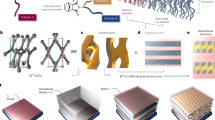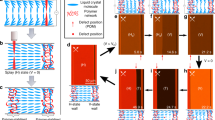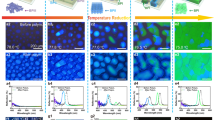Abstract
Topological defects in liquid crystals (LCs) have been widely used to organize colloidal dispersions and template polymerization, leading to a range of assemblies, elastomers and gels. However, little is understood about molecular-level assembly processes within defects. Here, we report that nanoscopic environments defined by LC topological defects can selectively trigger processes of molecular self-assembly. By using fluorescence microscopy, cryogenic transmission electron microscopy and super-resolution optical microscopy, we observed signatures of molecular self-assembly of amphiphilic molecules in topological defects, including cooperativity, reversibility and controlled growth. We also show that nanoscopic o-rings synthesized from Saturn-ring disclinations and other molecular assemblies templated by defects can be preserved by using photocrosslinkable amphiphiles. Our results reveal that, in analogy to other classes of macromolecular templates such as polymer–surfactant complexes, topological defects in LCs are a versatile class of three-dimensional, dynamic and reconfigurable templates that can direct processes of molecular self-assembly.
This is a preview of subscription content, access via your institution
Access options
Subscribe to this journal
Receive 12 print issues and online access
$259.00 per year
only $21.58 per issue
Buy this article
- Purchase on Springer Link
- Instant access to full article PDF
Prices may be subject to local taxes which are calculated during checkout






Similar content being viewed by others
References
Alden, J. S. et al. Strain solitons and topological defects in bilayer graphene. Proc. Natl Acad. Sci. USA 110, 11256–11260 (2013).
Lu, K., Lu, L. & Suresh, S. Strengthening materials by engineering coherent internal boundaries at the nanoscale. Science 324, 349–352 (2009).
Weber, C. A., Bock, C. & Frey, E. Defect-mediated phase transitions in active soft matter. Phys. Rev. Lett. 112, 168301 (2014).
Sachet, E. et al. Dysprosium-doped cadmium oxide as a gateway material for mid-infrared plasmonics. Nature Mater. 14, 414–420 (2015).
van der Zande, A. M. et al. Grains and grain boundaries in highly crystalline monolayer molybdenum disulphide. Nature Mater. 12, 554–561 (2013).
Liu, Q. et al. Self-alignment of plasmonic gold nanorods in reconfigurable anisotropic fluids for tunable bulk metamaterial applications. Nano Lett. 10, 1347–1353 (2010).
Dickson, W., Wurtz, G. A., Evans, P. R., Pollard, R. J. & Zayats, A. V. Electronically controlled surface plasmon dispersion and optical transmission through metallic hole arrays using liquid crystal. Nano Lett. 8, 281–286 (2008).
Wood, T. A., Lintuvuori, J. S., Schofield, A. B., Marenduzzo, D. & Poon, W. C. K. A self-quenched defect glass in a colloid-nematic liquid crystal composite. Science 334, 79–83 (2011).
Bukusoglu, E., Pal, S. K., de Pablo, J. J. & Abbott, N. L. Colloid-in-liquid crystal gels formed via spinodal decomposition. Soft Matter 10, 1602–1610 (2014).
Kikuchi, H., Yokota, M., Hisakado, Y., Yang, H. & Kajiyama, T. Polymer-stabilized liquid crystal blue phases. Nature Mater. 1, 64–68 (2002).
Xiang, J. & Lavrentovich, O. D. Blue-phase-polymer-templated nematic with sub-millisecond broad-temperature range electro-optic switching. Appl. Phys. Lett. 103, 051112 (2013).
Castles, F. et al. Stretchable liquid-crystal blue phase gels. Nature Mater. 13, 817–821 (2014).
Huck, W. T. S. Nanoscale Assembly: Chemical Techniques (Springer, 2005).
Zhao, X. et al. Molecular self-assembly and applications of designer peptide amphiphiles. Chem. Soc. Rev. 39, 3480–3498 (2010).
Chakrabarty, R., Mukherjee, P. S. & Stang, P. J. Supramolecular coordination: Self-assembly of finite two- and three-dimensional ensembles. Chem. Rev. 111, 6810–6918 (2011).
de Gennes, P. G. & Prost, J. The Physics of Liquid Crystals (Oxford Science Publications, 1993).
Gu, Y. & Abbott, N. L. Observation of Saturn-ring defects around solid microspheres in nematic liquid crystals. Phys. Rev. Lett. 85, 4719–4722 (2000).
Tkalec, U., Ravnik, M., Copar, S., Zumer, S. & Musevic, I. Reconfigurable knots and links in chiral nematic colloids. Science 333, 62–65 (2011).
Martinez, A. et al. Mutually tangled colloidal knots and induced defect loops in nematic fields. Nature Mater. 13, 258–263 (2014).
Mottram, N. J. & Sluckin, T. J. Defect-induced melting in nematic liquid crystals. Liq. Cryst. 27, 1301–1304 (2000).
Ravnik, M. & Zumer, S. Landau–de Gennes modelling of nematic liquid crystal colloids. Liq. Cryst. 36, 1201–1214 (2009).
Iliopoulos, I., Wang, T. K. & Audebert, R. Viscometric evidence of interactions between hydrophobically modified poly(sodium acrylate) and sodium dodecyl-sulfate. Langmuir 7, 617–619 (1991).
Hansson, P. & Lindman, B. Surfactant–polymer interactions. Curr. Opin. Colloid Interface Sci. 1, 604–613 (1996).
Yekta, A., Duhamel, J., Brochard, P., Adiwidjaja, H. & Winnik, M. A. A fluorescent-probe study of micelle-like cluster formation in aqueous-solutions of hydrophobically modified poly(ethylene oxide). Macromolecules 26, 1829–1836 (1993).
Biggs, S., Selb, J. & Candau, F. Effect of surfactant on the solution properties of hydrophobically modified polyacrylamide. Langmuir 8, 838–847 (1992).
Tanaka, R., Meadows, J., Williams, P. A. & Phillips, G. O. Interaction of hydrophobically modified (hydroxyethyl) cellulose with various added surfactants. Macromolecules 25, 1304–1310 (1992).
Guillemet, F. & Piculell, L. Interactions in aqueous mixtures of hydrophobically-modified polyelectrolyte and oppositely charged surfactant-mixed micelle formation and associative phase separation. J. Phys. Chem. 99, 9201–9209 (1995).
Piculell, L., Guillemet, F., Thuresson, K., Shubin, V. & Ericsson, O. Binding of surfactants to hydrophobically modified polymers. Adv. Colloid Interface Sci. 63, 1–21 (1996).
Mikhalyov, I., Gretskaya, N., Bergstrom, F. & Johansson, L. B. Electronic ground and excited state properties of dipyrrometheneboron difluoride (BODIPY): Dimers with application to biosciences. Phys. Chem. Chem. Phys. 4, 5663–5670 (2002).
Yoon, D. K. et al. Internal structure visualization and lithographic use of periodic toroidal holes in liquid crystals. Nature Mater. 6, 866–870 (2007).
Pires, D., Fleury, J. & Galerne, Y. Colloid particles in the interaction field of a disclination line in a nematic phase. Phys. Rev. Lett. 98, 247801 (2007).
Skarabot, M. et al. Hierarchical self-assembly of nematic colloidal superstructures. Phys. Rev. E 77, 061706 (2008).
Fleury, J., Pires, D. & Galerne, Y. Self-connected 3D architecture of microwires. Phys. Rev. Lett. 103, 267801 (2009).
Milette, J. et al. Reversible long-range patterning of gold nanoparticles by smectic liquid crystals. Soft Matter 8, 6593–6598 (2012).
Coursault, D. et al. Linear self-assembly of nanoparticles within liquid crystal defect arrays. Adv. Mater. 24, 1461–1465 (2012).
Voloschenko, D., Pishnyak, O. P., Shiyanovskii, S. V. & Lavrentovich, O. D. Effect of director distortions on morphologies of phase separation in liquid crystals. Phys. Rev. E 65, 060701 (2002).
Higashiguchi, K., Yasui, K., Ozawa, M., Odoi, K. & Kikuchi, H. Spatial distribution control of polymer nanoparticles by liquid crystal disclinations. Polym. J. 44, 632–638 (2012).
Karjiban, R. A., Shaari, N. S., Gunasakaran, U. V. & Basri, M. A coarse-grained molecular dynamics study of DLPC, DMPC, DPPC, and DSPC mixtures in aqueous solution. J. Chem. 2013, 931051 (2013).
Hiemenz, P. S. & Rajagopalan, R. Principles of Colloidal and Surface Chemistry (CRC, 1997).
Holmberg, K., Jonsson, B., Kronberg, B. & Lindman, B. Surfactants and Polymers in Aqueous Solution (Wiley, 2003).
Abe, A., Furuya, H., Shimizu, R. N. & Nam, S. Y. Calculation of the conformation entropies of dimer liquid crystals and comparison with the observed transition entropies at constant volume. Macromolecules 28, 96–103 (1995).
Israelachvili, J. N. Intermolecular and Surface Forces (Elsevier, 2011).
Nagarajan, R. & Ruckenstein, E. Theory of surfactant self-assembly: A predictive molecular thermodynamic approach. Langmuir 7, 2934–2969 (1991).
Ruckenstein, E., Huber, G. & Hoffmann, H. Surfactant aggregation in the presence of polymers. Langmuir 3, 382–387 (1987).
Nagarajan, R. Thermodynamics of nonionic polymer-micelle association. Colloids Surf. 13, 1–17 (1985).
Punnamaraju, S., You, H. & Steckl, A. J. Triggered release of molecules across droplet interface bilayer lipid membranes using photopolymerizable lipids. Langmuir 28, 7657–7664 (2012).
Iwata, T. et al. Control of cross-linking polymerization kinetics and polymer aggregated structure in polymer-stabilized liquid crystalline blue phases. Macromolecules 42, 2002–2008 (2009).
Lin, I. et al. Endotoxin-induced structural transformations in liquid crystalline droplets. Science 332, 1297–1300 (2011).
Miller, D. S. & Abbott, N. L. Influence of droplet size, pH and ionic strength on endotoxin-triggered ordering transitions in liquid crystalline droplets. Soft Matter 9, 374–382 (2013).
Dempsey, G. T., Vaughan, J. C., Chen, K. H., Bates, M. & Zhuang, X. Evaluation of fluorophores for optical performance in localization-based super-resolution imaging. Nature Methods 8, 1027–1040 (2011).
Gupta, R., Muralidhara, H. S. & Davis, H. T. Structure and phase behavior of phospholipid-based micelles in nonaqueous media. Langmuir 17, 5176–5183 (2001).
Danino, D., Gupta, R., Satyavolu, J. & Talmon, Y. Direct cryogenic-temperature transmission electron microscopy imaging of phospholipid aggregates in soybean oil. J. Colloid Interface Sci. 249, 180–186 (2002).
Salentinig, S., Sagalowicz, L., Leser, M. E., Tedeschi, C. & Glatter, O. Transitions in the internal structure of lipid droplets during fat digestion. Soft Matter 7, 650–661 (2011).
Kofiman, N., Schnabel-Lubovsky, M. & Talmon, Y. Nanostructure formation in the lecithin/isooctane/water system. J. Phys. Chem. B 117, 9558–9567 (2013).
Lee, H.-Y., Hashizaki, K., Diehn, K. & Raghavan, S. R. Reverse self-assembly of lipid onions induced by gadolinium and calcium ions. Soft Matter 9, 200–207 (2013).
Acknowledgements
This work was supported by the National Science Foundation (under awards DMR-1121288 (MRSEC) and CBET-1263970), the Army Research Office (W911-NF-11-1-0251 and W911-NF-14-1-0140), and the National Institutes of Health (CA108467 and AI092004). STORM imaging and analysis was performed at the Biochemistry Optical Core, University of Wisconsin-Madison.
Author information
Authors and Affiliations
Contributions
X.W., J.J.d.P. and N.L.A. designed the experiments. X.W., D.S.M. and E.B. performed the experimental work. X.W. and N.L.A. analysed the data. X.W., D.S.M., J.J.d.P. and N.L.A. wrote the paper. N.L.A. supervised the research. All authors discussed the progress of research and reviewed the manuscript.
Corresponding author
Ethics declarations
Competing interests
The authors declare no competing financial interests.
Supplementary information
Supplementary Information
Supplementary Information (PDF 1565 kb)
Rights and permissions
About this article
Cite this article
Wang, X., Miller, D., Bukusoglu, E. et al. Topological defects in liquid crystals as templates for molecular self-assembly. Nature Mater 15, 106–112 (2016). https://doi.org/10.1038/nmat4421
Received:
Accepted:
Published:
Issue Date:
DOI: https://doi.org/10.1038/nmat4421
This article is cited by
-
Liquid crystal defect structures with Möbius strip topology
Nature Physics (2023)
-
Self-assembled liquid crystal architectures for soft matter photonics
Light: Science & Applications (2022)
-
Autonomous materials systems from active liquid crystals
Nature Reviews Materials (2021)
-
Emerging nanoscience with discotic liquid crystals
Polymer Journal (2021)
-
Dynamics of topological defects and structural synchronization in a forming periodic tissue
Nature Physics (2021)



